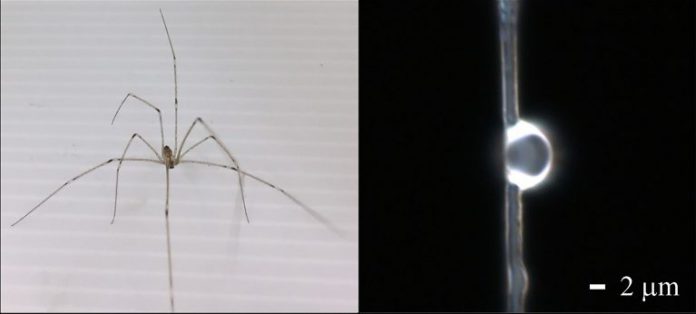What comes to mind while looking at the spider?
Web? Insect Catcher? Fear?
These are the three most common thoughts that flash whenever a spider is crawling across the field of vision!
There is more to it!
The modern technology has utilized the spectacular ability of the spider to spin a web. Its no surprise in the modern-day that spider silk has been used for biomedical purposes due to it being superior to the synthetic fibers for tissue engineering. But the team of researchers at the Tamkang University and National Yang-Ming University in Taiwan went a step ahead in utilizing the spider silk.
They have explained and described the use of natural silk spun by the spider in creating lenses, as stated in the Journal of Applied Physics. A special type of silk called the ‘Dragline silk,’ which is produced by the Pholcus phalangioides spiders to create spokes of their webs, has spectacular optical and mechanical properties, making it ideal for lenses. Although it is lightweight, it is greater than steel.
Cheng-Yang Liu, a professor at National Yang-Ming University and of the authors of the study, said:
“Dragline silk is an interesting natural material because of its significant features, such as high elasticity, great toughness, and large tensile strength.”
For the study, the participating researchers and authors collected smooth, uniform dragline silk from Pholcus phalangioides spiders. These spiders are also called daddy longlegs owing to their physical appearance.
The collected silk is then covered with resin by dripping resin over it and letting the resin condense. The dragline silk has wetting properties which condense the resin in a dome shape, resembling an optical lens. The resultant silk was then studied for its ability to be used as an optical lens.
A laser was shone onto the lens, which generated a high-quality photonic nanojet. The resin-dripping time can be altered to change the size of the lens, which would subsequently optimize the photonic nanojets to produce the desired type of imaging.
What is a photonic nanojet?
A photonic nanojet is a type of beam that can provide large-area, super-resolution imaging for biomedical applications.
Cheng-Yang Liu said:
“The dome lens with flexible photonic nanojets is suitable for imaging the nanoscale objectives in different depths within biological tissue.”
Future prospects:
Researchers are adamant about conducting further research to conclusively determine the use of spider silk-based lenses in delivering light for biological imaging and operation.
Reference:
C. B. Lin, Yi-Ting Lee, Cheng-Yang Liu. Optimal photonic nanojet beam shaping by mesoscale dielectric dome lens. Journal of Applied Physics, 2020; 127 (24): 243110 DOI: 10.1063/5.0007611




